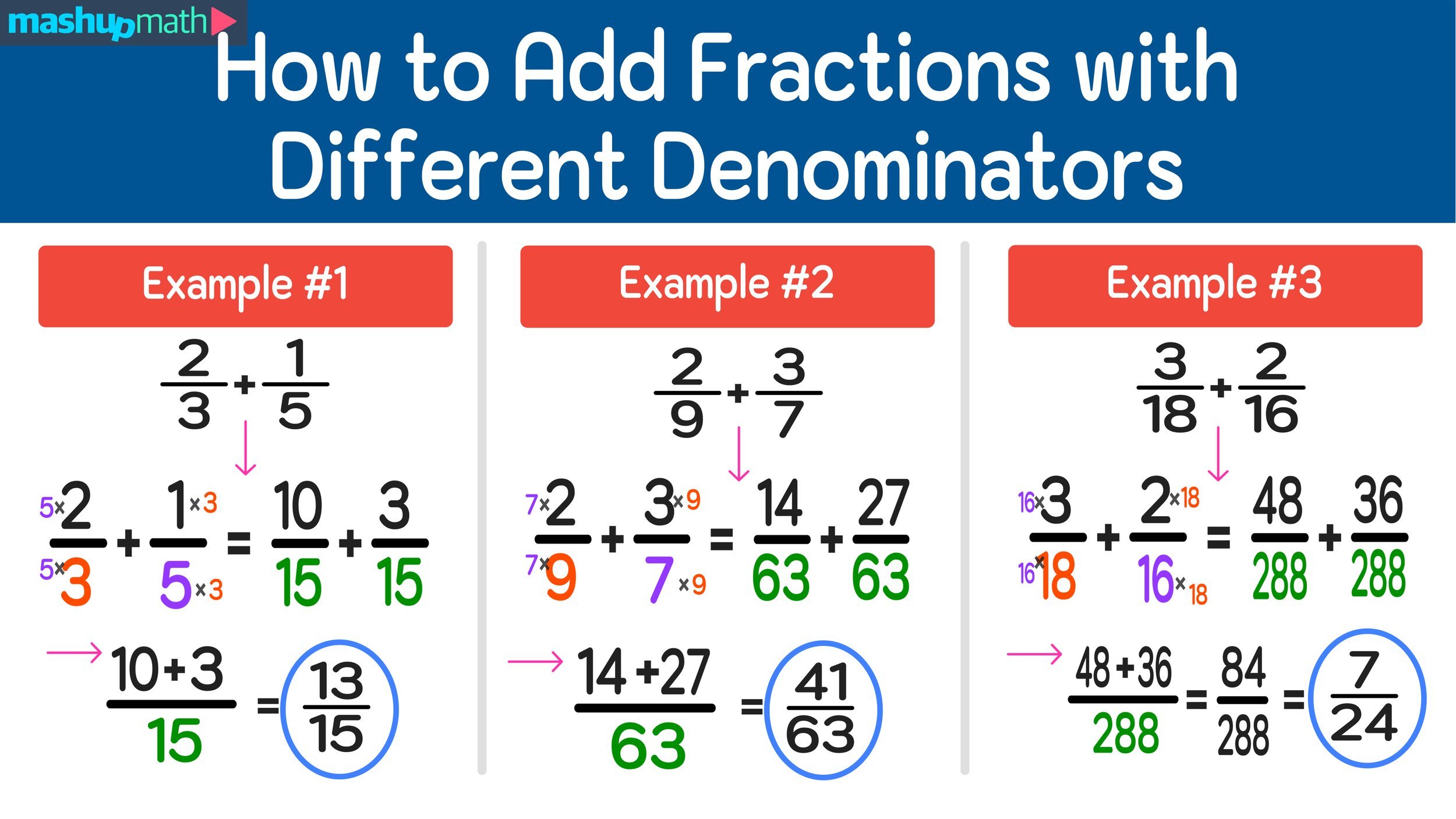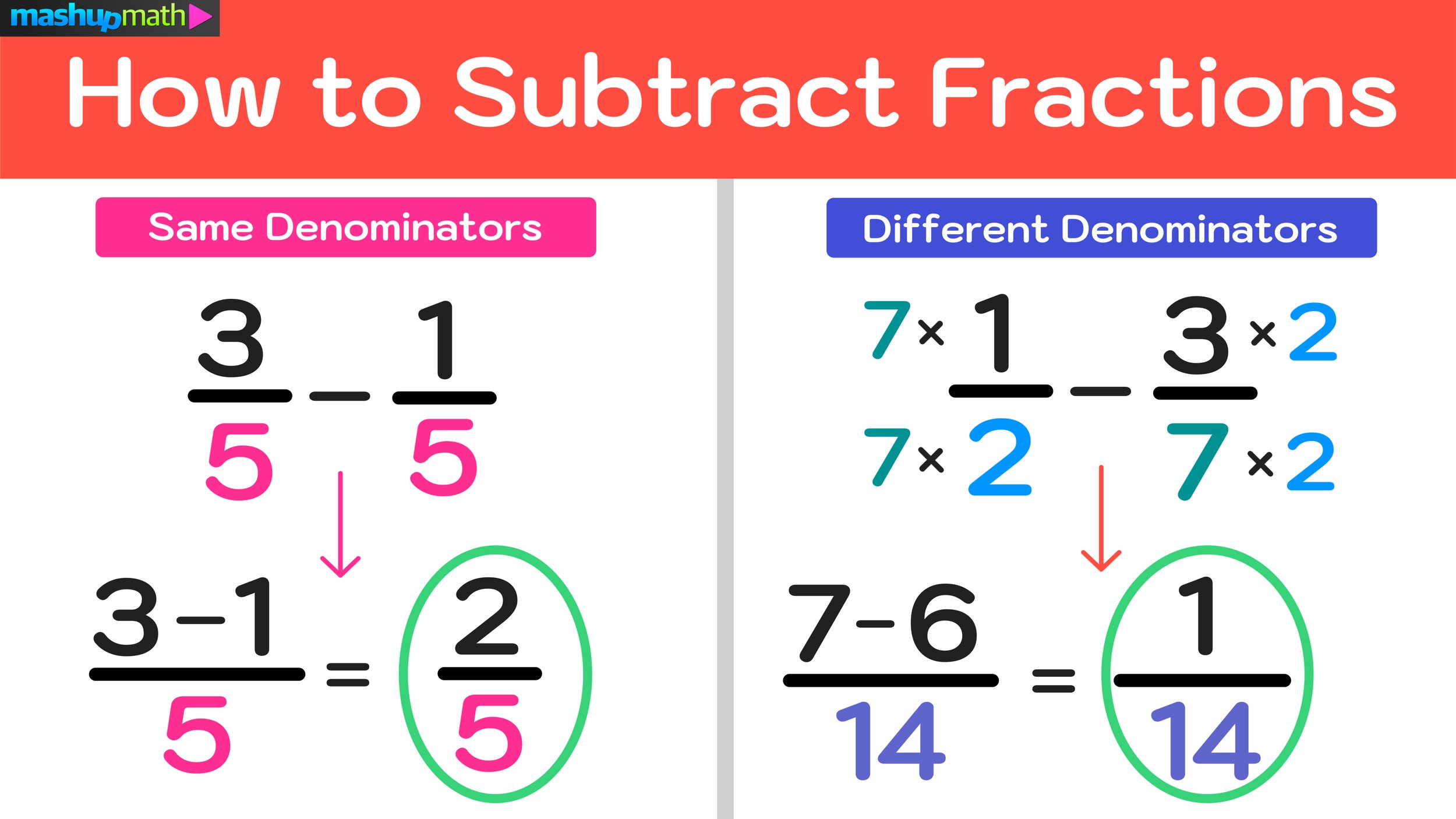How to Subtract Fractions with Different Denominators
Math Skills: How to Subtract Fractions with Unlike Denominators in 3 Easy Steps
Subtracting Fractions with Different Denominators
Learning how to add and subtract fractions with different denominators is an important math skill that requires a strong understanding of fractions overall. After you learn how to subtract fractions with the same denominator, the next step is to learn how to subtract fractions with different denominators (i.e. how to subtract fractions with unlike denominators).
Subtracting fractions with the same denominator is a pretty straightforward task, but problems involving subtracting fractions with unlike denominators can be more challenging. However, the overall process for subtracting fractions with unlike denominators is a skill that can be mastered by learning a few simple steps and by working through practice problems (and this is exactly what this step-by-step guide will entail).
This free guide on How to Add Subtract with Different Denominators will teach you everything you need to know about subtracting fractions. Together, we will learn a simple 3-step strategy for subtracting fractions that you will be able to use to solve any subtracting fractions with unlike denominators problem.
While we highly recommend that you follow each section of the guide in order, you can click on any of the quick-links below to jump to a specific section.
How to Subtract Fractions with Different Denominators: 3-Step Strategy
How to Subtract Fractions with Different Denominators Example #1
How to Subtract Fractions with Different Denominators Example #2
How to Subtract Fractions with Different Denominators Example #3
Before we get started with learning the 3-step strategy or working on the practice problems, we will do a quick recap of fractions and what it means to subtract fractions with unlike denominators.
Recap: Subtracting Fractions with the Same Denominator
Let’s start by recapping two important vocabulary terms related to fractions:
Definition: The numerator of a fraction is the top number. For example, 2/3 has a numerator of 2.
Definition: The denominator of a fraction is the bottom number. For example, 2/3 has a denominator of 3.
Throughout this tutorial, we will make several references to the numerator and denominator of a fraction, so be sure that you have a firm understanding of these two vocabulary terms before going any further.
Figure 01: Every fraction has a top number (numerator) and a bottom number (denominator).
Subtracting fractions with the same denominator is a relatively simple task.
For example, consider the following problem where you have to subtract one fraction from another:
3/4 - 1/4 = ?
Both of the fractions, 3/4 and 1/4, have the same denominator (i.e. both fractions have 4 as the denominator).
For examples such as this, if both fractions have a common denominator, all you have to do to solve the problem is to subtract the second numerator from the first numerator and keep the denominator the same. This can be done as follows:
3/4 - 1/4 = (3-1)/4 = 2/4
Notice that our result, 2/4, can be simplified to 1/2 (since both the numerator and the denominator share a greatest common factor of 2, we can reduce by dividing both numbers by 2).
So, we can conclude that:
Final Answer: 3/4 - 1/4 = 1/2
Figure 02 below illustrates how we solved this problem. For a deeper dive into subtracting fractions with the same denominator, we suggest reviewing our free How to Subtract Fractions Student Guide before going any further.
The key takeaway from this review of how to subtract fractions with the same denominator is that whenever you are subtracting fractions with the same denominator, find the difference of the numerators and leave the denominator the same.
Figure 02: Subtracting fractions with the same denominator.
Now we are ready to move onto the next section, which will focus on how to subtract fractions with unlike denominators using a 3-step strategy.
How to Subtract Fractions with Unlike Denominators Step-by-Step
First, let’s recall the sample problem from the previous section when we reviewed how to subtract fractions with a common denominator:
3/4 - 1/4 = ?
For this problem, we concluded that the answer is 1/2. Now, let’s look at another practice problem where the fractions have unlike denominators:
3/4 - 2/8 = ?
Notice that, in this problem, one fraction has a denominator of 4 and the other has a denominator of 8 (i.e. the denominators are different).
However, if we compare both problems, we should notice that they are equivalent to each other. Namely, the second fraction in both problems represent “one-quarter” since 1/4 and 2/8 are equivalent fractions.
What does this mean? Both problems represent the difference of three-quarters and one quarter. However, the first problem has common denominators and the section problem does not.
With this difference in mind, we will go ahead and learn how to use a 3-step strategy for subtracting fractions with unlike denominators to solve this problem to see if we get the same result (i.e. the final answer is 1/2).
Figure 03: The expressions 3/4 - 1/4 and 3/4 - 2/8 are equivalent (i.e. they both represent “three-quarters minus one-quarter.”
How to Subtract Fractions with Unlike Denominators:
Step One: Find a common denominator by multiplying each fraction by the opposite fraction’s denominator.
Step Two: Subtract the second numerator from the first numerator and keep the denominator.
Step Three: Reduce the result if possible.
Now that you know the 3-step strategy for subtracting fractions with unlike denominators, let’s apply them to solving the problem 3/4 - 2/8 = ?.
Step One: Find a common denominator by multiplying each fraction by the opposite fraction’s denominator.
For step one, we have to find a common denominator.
Definition: In math, a common denominator is a common value that the denominators of both fractions can be divided into evenly.
While there are a few ways to find a common denominator between two fractions, the simplest way is to multiply the denominator of the first fraction by the second fraction and vice versa (i.e. multiply the denominator of the second fraction by the first fraction).
For the problem 3/4 - 2/8 = ?, we can use this approach to finding a common denominator as follows:
3/4 - 2/8 = (3x8)/(4x8) - (2x4)/(8x4) = 24/32 - 8/32
Now we have a new equivalent expression, 24/32 - 8/32, where the denominators are the same. And, since the denominators of this new equivalent expression are the same, we can say that we have found a common denominator and we can move onto step two.
Figure 04: How to find a common denominator between two fractions.
Step Two: Subtract the second numerator from the first numerator and keep the denominator.
For the second step, we will focus on our new expression where the fractions share a common denominator of 32:
3/4 - 2/8 → 24/32 - 8/32
From here, we can solve 24/32 - 8/32 by finding the difference of the numerators and leaving the denominator the same:
24/32 - 8/32 = (24-8)/32 = 16/32
Step Three: Reduce the result if possible.
Lastly, we have to check and see whether or not our result, 13/15, can be simplified. Since both 16 and 32 share a greatest common factor of 16, we can divide both the numerator, 16, and the denominator, 32, by 16 to get an answer in reduced form:
(16÷16)/(32÷16) = 1/2
So, we can conclude that:
Final Answer: 3/4 - 2/8 = 1/2
Figure 05: How to Subtract Fractions with Different Denominators in 3 Steps.
Our final answer should look familiar. Remember that we already knew that our answer would be 1/2 since we know that three-quarters minus one-quarter equals one-half. The key takeaway here is understanding that our 3-step strategy will allow us to correctly solve any problem where you are tasked with subtracting fractions with the same denominator.
Now, let’s go ahead and get some more practice using the 3-step strategy for subtracting fractions with unlike denominators.
How to Subtract Fractions with Different Denominators Example #1
Example #1: 4/5 - 2/3
For this first example, we want to find the difference between four-fifths (4.5) and two-thirds (2/3). To solve this problem, we can use of 3-step strategy as follows:
Step One: Find a common denominator by multiplying each fraction by the opposite fraction’s denominator.
First, we have to find a common denominator by multiplying the denominator of the first fraction (5) by the second fraction (2/3) and then by multiplying the denominator of the second fraction (3) by the first fraction (4/5):
4/5 - 2/3 = (3x4)/(3x5) - (5x2)/(5x3) = 12/15 - 10/15
Notice that we now have a new equivalent expression with common denominators (i.e. both fractions have the same denominator, which, in this case, is 15).
4/5 - 2/3 → 12/15 - 10/15
Step Two: Subtract the second numerator from the first numerator and keep the denominator.
For the second step, we can solve 12/15 - 10/15 = ? as follows:
12/15 - 10/15 = (12-10)/15 = 2/15
Step Three: Reduce the result if possible.
And now, for the final step, we just have to see if the result, 2/15, can be simplified. Since 2 and 15 do not have any factors in common (other than 1), this fraction is already in reduced form and can not be simplified further. Therefore…
Final Answer: 4/5 - 2/3 = 2/15
The entire 3-step process for solving this first example is illustrated in Figure 06 below:
Figure 06: How to Subtract Fractions with Unlike Denominators
How to Subtract Fractions with Unlike Denominators Example #2
Example #2: 3/7 - 2/9
Just like the last example, we can use our 3-step strategy to solve this problem.
Step One: Find a common denominator by multiplying each fraction by the opposite fraction’s denominator.
To find a common denominator, we can multiply the first fraction, 3/7, by the denominator of the second fraction, 9, and then multiply the second fraction, 2/9, by the denominator of the first fraction, 7, as follows:
3/7 - 2/9 = (9x3)/(9x7)-(7x2)/(7x9) = 27/63 - 14/63
Now we have found an expression that is equivalent to the original problem:
3/7 - 2/9 → 27/63 - 14/63
Step Two: Subtract the second numerator from the first numerator and keep the denominator.
Next, we can go ahead and solve 27/63 - 14/63 as follows:
27/63 - 14/63 = (27-14)/63 = 13/63
Step Three: Reduce the result if possible.
For the very last step, we just have to see if our result, 13/63, can be simplified any further. Notice that 13 and 63 do not share any common factors besides 1, so we can conclude that 13/63 can not be simplified and:
Final Answer: 3/7 - 2/9 = 13/63
All of the steps for solving this second example are detailed in Figure 07 below.
Figure 07: Subtracting Fractions Explained!
Are you feeling more confident with using the 3-step strategy to subtract fractions with unlike denominators? If not, let’s go ahead and gain some more experience by working through one more practice problem.
How to Subtract Fractions with Different Denominators Example #3
Example #3: 7/8 - 4/24
For this last example, we can again use the 3-step strategy to solve it:
Step One: Find a common denominator by multiplying each fraction by the opposite fraction’s denominator.
First, we can find a common denominator by taking each fraction and multiplying it by the denominator of the opposite fraction:
7/8 - 4/24 = (24x7)/(24x8) - (8x4)/(8x24) = 168/192 - 32/192
Now we have a new expression where both fractions share a common denominator:
7/8 - 4/24 → 168/192 - 32/192
Step Two: Subtract the second numerator from the first numerator and keep the denominator.
Next, we have to solve:
168/192 - 32/192 = (168-32)/192 = 136/192
Step Three: Reduce the result if possible.
One more step! To wrap this problem up, we have to try and simplify 136/192. We know that this fraction can be reduced since both 136 and 192 share 2 as a common factor. However, they actually share a greater common factor, which is 8. So, after we divide the numerator, 136, and the denominator, 192, by 8, we are left with 17/24, and we can conclude that:
Final Answer: 7/8 - 4/24 = 17/24
The complete step-by-step process of solving Example #3 is illustrated in Figure 08 below.
Figure 08: How to Subtract Fractions with Different Denominators
Conclusion: How to Subtract Fractions with Different Denominators
Subtracting fractions with unlike denominators is a foundational math skill that every student must master when learning how to perform operations with fractions.
This step-by-step tutorial on subtracting fractions focused on teaching you how to find the difference between two fractions that do not have the same denominator.
To solve problems where you have to subtract fractions with unlike denominators, we used the following 3-step strategy:
Step One: Find a common denominator by multiplying each fraction by the opposite fraction’s denominator.
Step Two: Subtract the second numerator from the first numerator and keep the denominator.
Step Three: Simplify the result if possible.
These three steps were used to solve the three example problems in this guide. They can also be used to solve any subtracting fractions problems that you may come across, so be sure to keep them in your notes and practice using them as often as you can!
























































